Im using Newtons equations to make the balls in this program that I'm currently working on to be "split" away when they collide with eachother, but sometimes they get stuck into eachother and that causes lot's of trouble.
.
This is my code:
<center>
<canvas id="canvas" style="border: 2px solid black; cursor: crosshair;" width="1000" height="500"></canvas>
</center>
<script>
var canvas = document.getElementById("canvas")
var ctx = canvas.getContext("2d")
var w = canvas.width
var h = canvas.height
var ball = []
var gravity = 0.3
var force = 0.2
var mouse = {
d: false,
x1: 0,
y1: 0,
x2: 0,
y2: 0,
}
window.onmousedown = function(e) {
mouse.d = true
mouse.x1 = mouse.x2 = e.pageX - canvas.getBoundingClientRect().left
mouse.y1 = mouse.y2 = e.pageY - canvas.getBoundingClientRect().top
}
window.onmousemove = function(e) {
if (mouse.d) {
mouse.x2 = e.pageX - canvas.getBoundingClientRect().left
mouse.y2 = e.pageY - canvas.getBoundingClientRect().top
} else {
mouse.x1 = mouse.x2 = e.pageX - canvas.getBoundingClientRect().left
mouse.y1 = mouse.y2 = e.pageY - canvas.getBoundingClientRect().top
}
}
window.onmouseup = function() {
if (mouse.d) {
mouse.d = false
var dx = (mouse.x1 - mouse.x2);
var dy = (mouse.y1 - mouse.y2);
var mag = Math.sqrt(dx * dx + dy * dy);
ball.push({
x: mouse.x1,
y: mouse.y1,
r: Math.floor(Math.random() * 20) + 10,
vx: dx / mag * -(mag * force),
vy: dy / mag * -(mag * force),
b: 0.7,
})
}
}
document.onselectstart = function() {return false}
document.oncontextmenu = function() {return false}
setInterval(update, 1000 / 60)
function update() {
ctx.clearRect(0, 0, w, h)
ctx.beginPath()
ctx.moveTo(mouse.x1, mouse.y1)
ctx.lineTo(mouse.x2, mouse.y2)
ctx.stroke()
ctx.closePath()
for (i = 0; i < ball.length; i++) {
ball[i].vy += gravity
ball[i].x += ball[i].vx
ball[i].y += ball[i].vy
if (ball[i].x > w - ball[i].r) {
ball[i].x = w - ball[i].r
ball[i].vx *= -ball[i].b
}
if (ball[i].x < ball[i].r) {
ball[i].x = ball[i].r
ball[i].vx *= -ball[i].b
}
if (ball[i].y > h - ball[i].r) {
ball[i].y = h - ball[i].r
ball[i].vy *= -ball[i].b
}
if (ball[i].y < ball[i].r) {
ball[i].y = ball[i].r
ball[i].vy *= -ball[i].b
}
for (j = i + 1; j < ball.length; j++) {
var dx = ball[i].x - ball[j].x
var dy = ball[i].y - ball[j].y
var dist = Math.sqrt(dx * dx + dy * dy)
if (Math.abs(dx) + Math.abs(dy) != 0 && dist <= ball[i].r + ball[j].r) {
var angle = Math.atan2(dy, dx)
var sp1 = Math.sqrt(ball[i].vx*ball[i].vx + ball[i].vy*ball[i].vy);
var sp2 = Math.sqrt(ball[j].vx*ball[j].vx + ball[j].vy*ball[j].vy);
var dir1 = Math.atan2(ball[i].vy, ball[i].vx);
var dir2 = Math.atan2(ball[j].vy, ball[j].vx);
var vx1 = sp1 * Math.cos(dir1 - angle);
var vy1 = sp1 * Math.sin(dir1 - angle);
var vx2 = sp2 * Math.cos(dir2 - angle);
var vy2 = sp2 * Math.sin(dir2 - angle);
var fvx1 = ((ball[i].r - ball[j].r) * vx1 + (2 * ball[j].r) * vx2) / (ball[i].r + ball[j].r);
var fvx2 = ((2 * ball[i].r) * vx1 + (ball[j].r - ball[i].r) * vx2) / (ball[i].r + ball[j].r);
var fvy1 = vy1;
var fvy2 = vy2;
ball[i].vx = Math.cos(angle) * fvx1 + Math.cos(angle + Math.PI/2) * fvy1;
ball[i].vy = Math.sin(angle) * fvx1 + Math.sin(angle + Math.PI/2) * fvy1;
ball[j].vx = Math.cos(angle) * fvx2 + Math.cos(angle + Math.PI/2) * fvy2;
ball[j].vy = Math.sin(angle) * fvx2 + Math.sin(angle + Math.PI/2) * fvy2;
}
}
ctx.beginPath()
ctx.arc(ball[i].x, ball[i].y, ball[i].r, 0, Math.PI * 2, false)
ctx.fillStyle = "black"
ctx.fill()
ctx.closePath()
}
}
</script>
And when you have lot's of balls spawned and their speed is fast this happens:

Why? Anyone know how I can fix this?